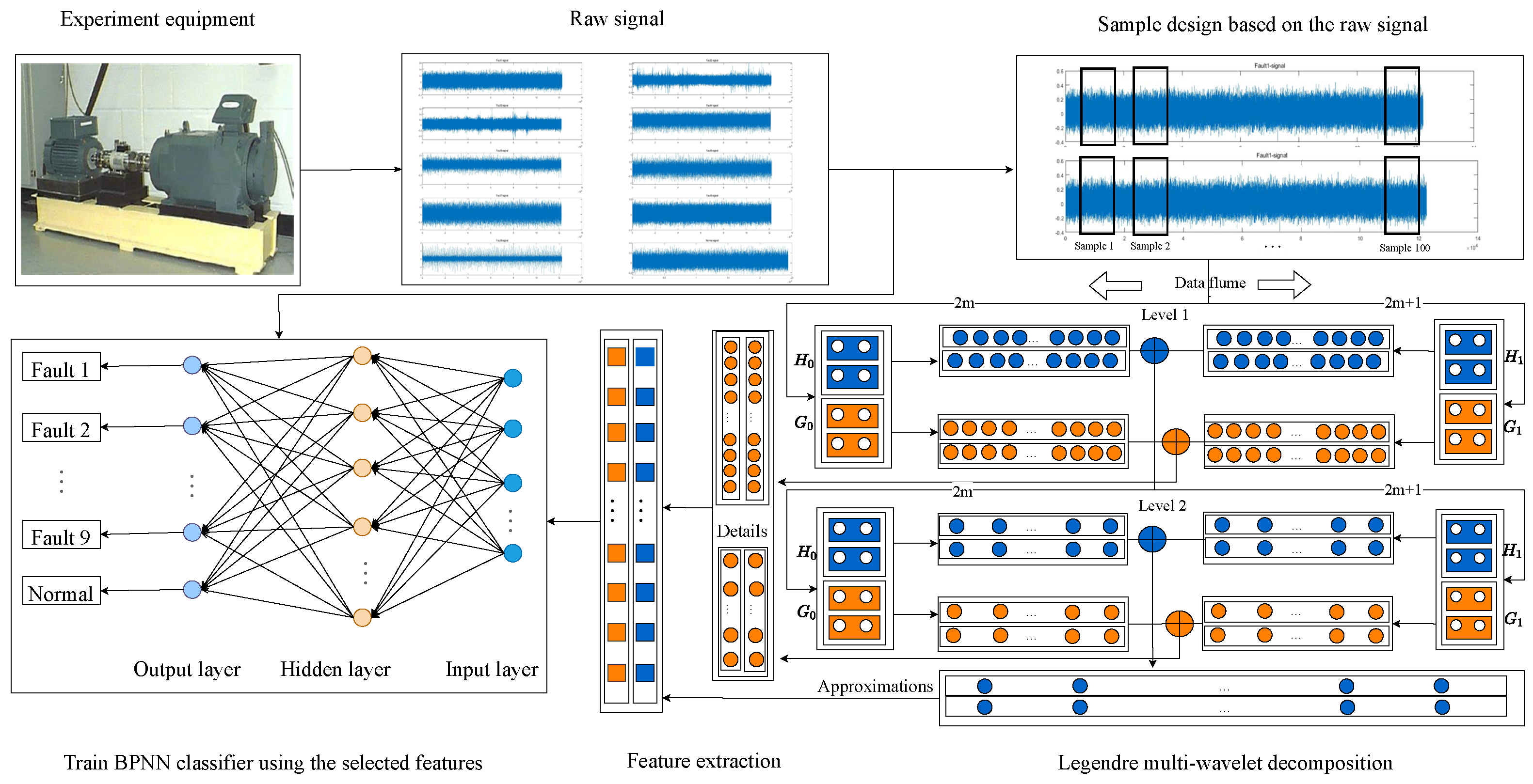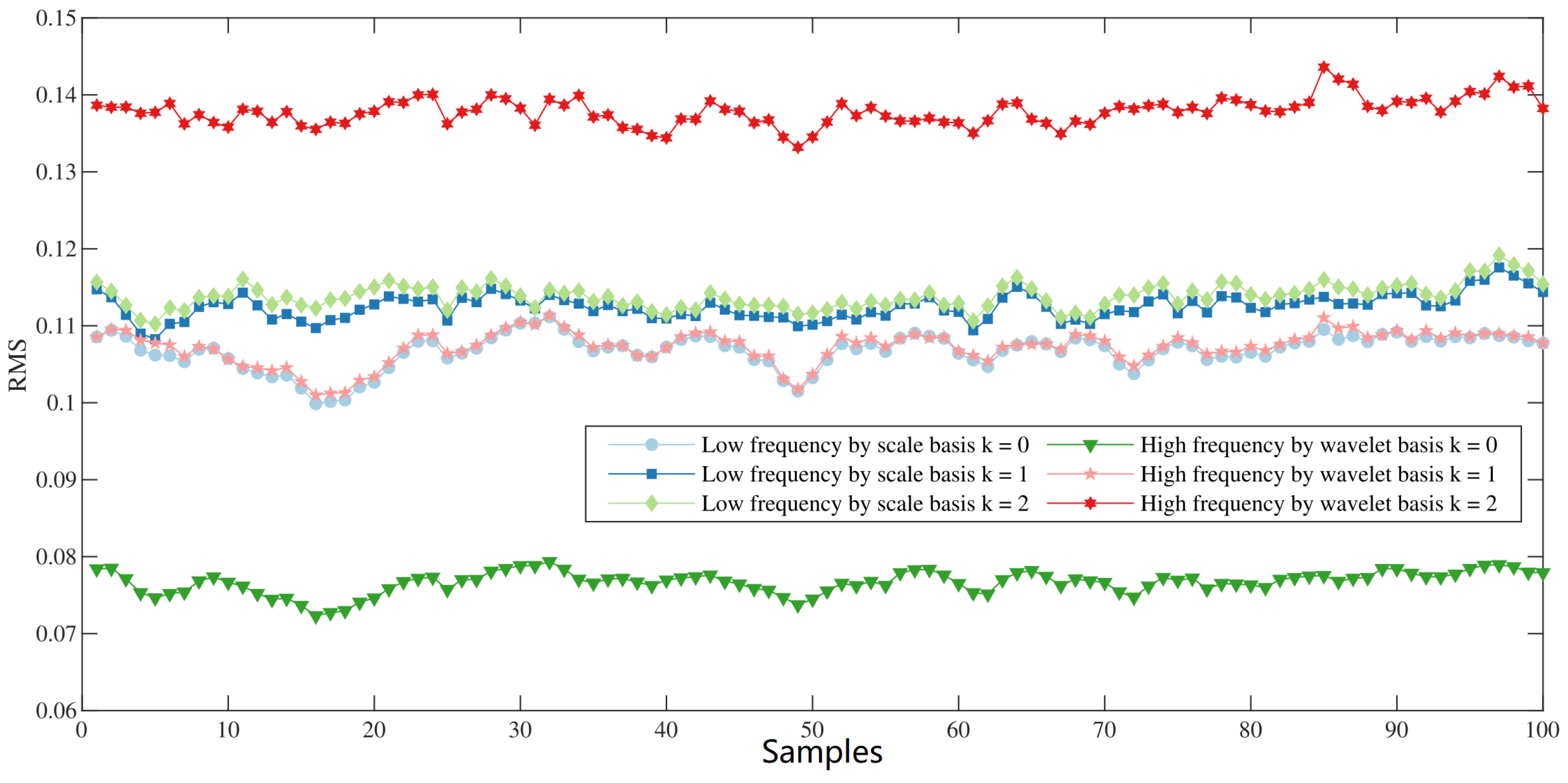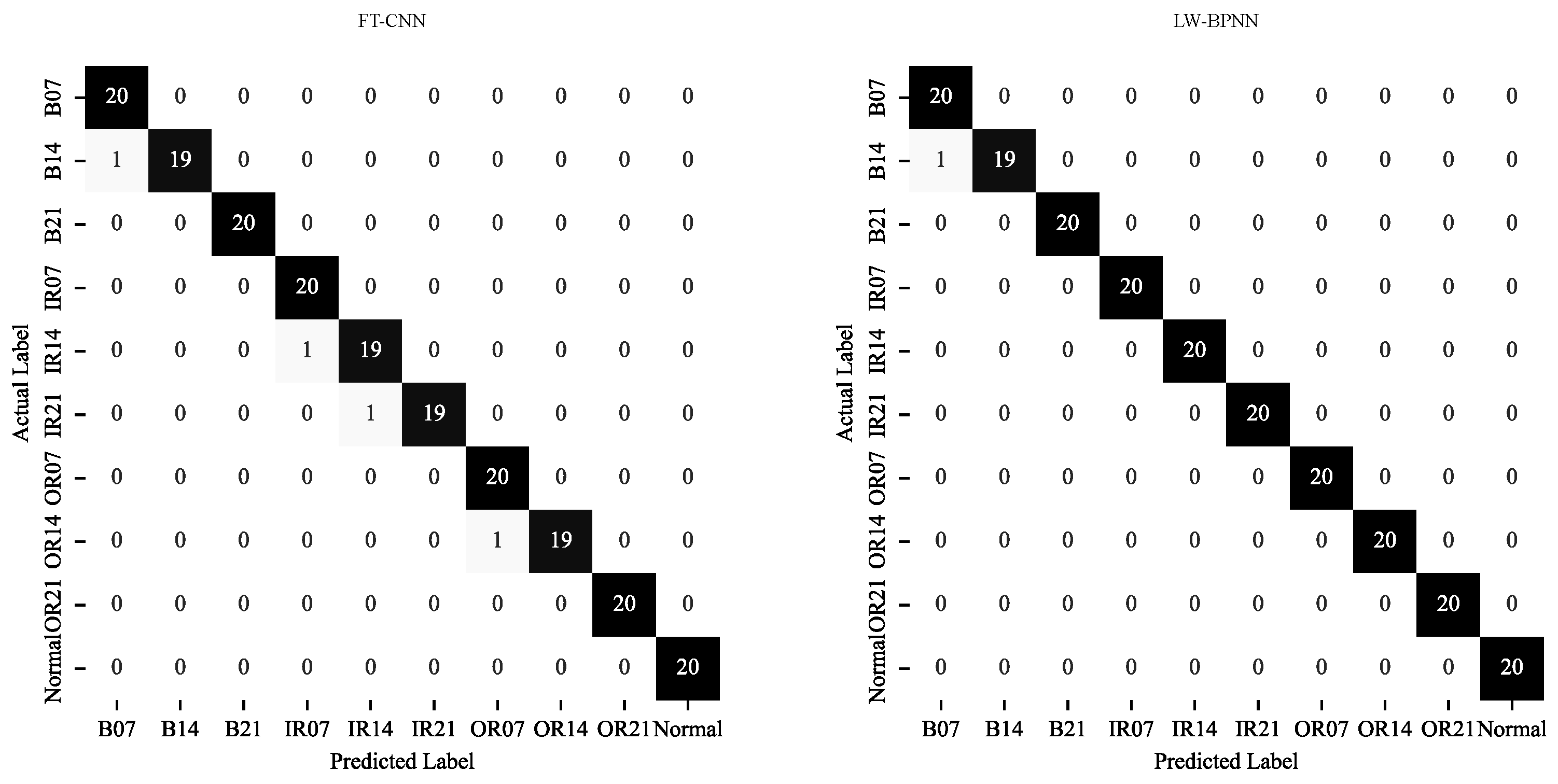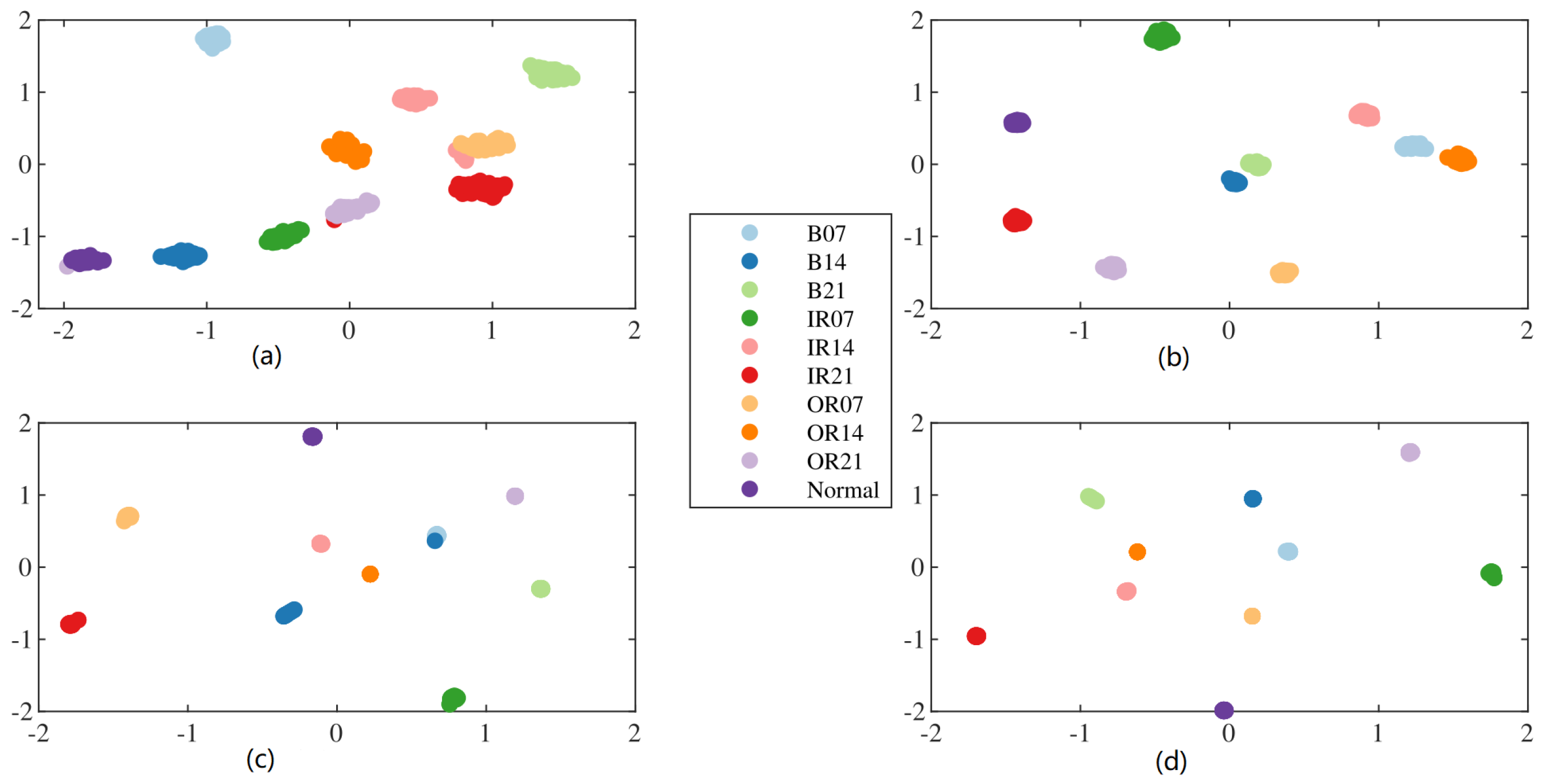LW-BPNN: A Novel Feature Extraction Method for Rolling Bearing Fault Diagnosis
Abstract
:1. Introduction
- (1)
- A small number of Legendre scales and wavelet base functions with rich vanishing moments and regularities can provide a powerful tool for feature extraction. It can effectively and precisely learn and distinguish the complex fault characteristics of bearings without redundancy or information leakage. The use of LWD significantly enhances diagnostic accuracy and drastically reduces the computational burden in selecting optimal features during different fault identification processes.
- (2)
- By combining with a relatively simple BPNN classifier, the difficulties of designing and training deep neural networks are avoided. This approach saves computational costs and is more feasible for implementing online fault diagnosis in rotating machinery.
- (3)
- The CWRU dataset is employed to validate the effectiveness and robustness of the proposed method. The corresponding diagnostic accuracy indicates superior classification performance can be achieved. Therefore, this intelligent fault diagnosis method offers a novel approach for practical industrial applications in rotating machinery.
- (4)
- Based on the decomposition and reconstruction experiment, LWT can not only effectively and efficiently extract internal features of various bearing faults from different decomposition levels without losing any information, but can also avoid the Gibbs phenomena usually shown by other multiwavelet transformation.
2. Legendre Multiwavelet Transform
2.1. Legendre Multiwavelet Bases
2.2. The Decomposition and Reconstruction
3. The Proposed Method
3.1. The Flowchart of the Proposed Method
3.2. Detailed Description of The Dataset
4. Experimental Validation and Result Analysis
4.1. Extraction Fault Characteristic
4.2. Comparison with Different Methods
4.2.1. Details of the Dataset Partition
4.2.2. Experimental Results
4.3. Comparison of Different Methods under Noisy Background Conditions
4.4. Visualizing The Features
5. Conclusions
Author Contributions
Funding
Data Availability Statement
Acknowledgments
Conflicts of Interest
Abbreviations
| LW-BPNN | Legendre multiwavelet transform combined with BPNN |
| BPNN | Back propagation neural network |
| RMS | Root mean square |
| SD | Standard deviation |
| SVM | Support vector machine |
| CNN | Convolutional neural network |
| RNN | Recurrent neural network |
| LWT | Legendre multiwavelet transform |
| LWD | Legendre multiwavelet decomposition |
| CWRU | Case Western Reserve University bearing dataset |
| FT-CNN | Fourier transform combined with CNN |
| FT-RNN | Fourier transform combined with RNN |
| DW-BPNN | Daubechies wavelet combined with BPNN |
| DW-SVM | Daubechies wavelet combined with SVM |
| LW-SVM | Legendre multiwavelet transform combined with SVM |
| t-SNE | t-Distributed stochastic neighbor embedding |
| SNRs | Signal-to-noise ratios |
References
- Randall, R.B.; Antoni, J. Rolling element bearing diagnostics—A tutorial. Mech. Syst. Signal Process. 2011, 25, 485–520. [Google Scholar] [CrossRef]
- Yang, S.; Gu, X.; Liu, Y.; Hao, R.; Li, S. A general multi-objective optimized wavelet filter and its applications in fault diagnosis of wheelset bearings. Mech. Syst. Signal Process. 2020, 145, 106914. [Google Scholar] [CrossRef]
- Dong, X.; Li, G.; Jia, Y.; Xu, K. Multiscale feature extraction from the perspective of graph for hob fault diagnosis using spectral graph wavelet transform combined with improved random forest. Measurement 2021, 176, 109178. [Google Scholar] [CrossRef]
- Rai, A.; Upadhyay, S. A review on signal processing techniques utilized in the fault diagnosis of rolling element bearings. Tribol. Int. 2016, 96, 289–306. [Google Scholar] [CrossRef]
- Wei, H.; Zhang, Q.; Shang, M.; Gu, Y. Extreme learning Machine-based classifier for fault diagnosis of rotating Machinery using a residual network and continuous wavelet transform. Measurement 2021, 183, 109864. [Google Scholar] [CrossRef]
- Chen, J.; Li, Z.; Pan, J.; Chen, G.; Zi, Y.; Yuan, J.; Chen, B.; He, Z. Wavelet transform based on inner product in fault diagnosis of rotating machinery: A review. Mech. Syst. Signal Process. 2016, 70–71, 1–35. [Google Scholar] [CrossRef]
- Almounajjed, A.; Sahoo, A.K.; Kumar, M.K. Diagnosis of stator fault severity in induction motor based on discrete wavelet analysis. Measurement 2021, 182, 109780. [Google Scholar] [CrossRef]
- Haidong, S.; Junsheng, C.; Hongkai, J.; Yu, Y.; Zhantao, W. Enhanced deep gated recurrent unit and complex wavelet packet energy moment entropy for early fault prognosis of bearing. Knowl.-Based Syst. 2020, 188, 105022. [Google Scholar] [CrossRef]
- Li, X.; Jiang, H.; Wang, R.; Niu, M. Rolling bearing fault diagnosis using optimal ensemble deep transfer network. Knowl.-Based Syst. 2021, 213, 106695. [Google Scholar] [CrossRef]
- Yan, X.; She, D.; Xu, Y.; Jia, M. Deep regularized variational autoencoder for intelligent fault diagnosis of rotor–bearing system within entire life-cycle process. Knowl.-Based Syst. 2021, 226, 107142. [Google Scholar] [CrossRef]
- Shao, H.; Jiang, H.; Wang, F.; Zhao, H. An enhancement deep feature fusion method for rotating machinery fault diagnosis. Knowl.-Based Syst. 2017, 119, 200–220. [Google Scholar] [CrossRef]
- Cheng, Y.; Wang, Z.; Chen, B.; Zhang, W.; Huang, G. An improved complementary ensemble empirical mode decomposition with adaptive noise and its application to rolling element bearing fault diagnosis. ISA Trans. 2019, 91, 218–234. [Google Scholar] [CrossRef]
- Yuan, R.; Lv, Y.; Li, H.; Song, G. Robust Fault Diagnosis of Rolling Bearings Using Multivariate Intrinsic Multiscale Entropy Analysis and Neural Network Under Varying Operating Conditions. IEEE Access 2019, 7, 130804–130819. [Google Scholar] [CrossRef]
- Yan, X.; Jia, M. Intelligent fault diagnosis of rotating machinery using improved multiscale dispersion entropy and mRMR feature selection. Knowl. Based Syst. 2019, 163, 450–471. [Google Scholar] [CrossRef]
- Dou, D.; Yang, J.; Liu, J.; Zhao, Y. A rule-based intelligent method for fault diagnosis of rotating machinery. Knowl. Based Syst. 2012, 36, 1–8. [Google Scholar] [CrossRef]
- Asr, M.Y.; Ettefagh, M.M.; Hassannejad, R.; Razavi, S.N. Diagnosis of combined faults in Rotary Machinery by Non-Naive Bayesian approach. Mech. Syst. Signal Process. 2017, 85, 56–70. [Google Scholar] [CrossRef]
- Wang, X.; Zi, Y.; He, Z. Multiwavelet construction via an adaptive symmetric lifting scheme and its applications for rotating machinery fault diagnosis. Meas. Sci. Technol. 2009, 20, 045103. [Google Scholar] [CrossRef]
- Yan, R.; Gao, R.X.; Chen, X. Wavelets for fault diagnosis of rotary machines: A review with applications. Signal Process. 2014, 96, 1–15. [Google Scholar] [CrossRef]
- Jiang, G.; He, H.; Yan, J.; Xie, P. Multiscale Convolutional Neural Networks for Fault Diagnosis of Wind Turbine Gearbox. IEEE Trans. Ind. Electron. 2019, 66, 3196–3207. [Google Scholar] [CrossRef]
- Zheng, X.; Yang, X.; Su, H.; Qiu, L. Discontinuous Legendre wavelet element method for elliptic partial differential equations. Appl. Math. Comput. 2011, 218, 3002–3018. [Google Scholar] [CrossRef]
- Huang, H.; Li, K.; Su, W.; Bai, J.; Xue, Z.; Zhou, L.; Su, L.; Pecht, M. An improved empirical wavelet transform method for rolling bearing fault diagnosis. Sci. China Technol. Sci. 2020, 63, 2231–2240. [Google Scholar] [CrossRef]
- Kuncan, M.; Kaplan, K.; Mi?naz, M.R.; Kaya, Y.; Ertunç, H.M. A novel feature extraction method for bearing fault classification with one dimensional ternary patterns. ISA Trans. 2020, 100, 346–357. [Google Scholar] [CrossRef]
- Liu, H.; Zhou, J.; Zheng, Y.; Jiang, W.; Zhang, Y. Fault diagnosis of rolling bearings with recurrent neural network-based autoencoders. ISA Trans. 2018, 77, 167–178. [Google Scholar] [CrossRef]
- Pandya, D.; Upadhyay, S.; Harsha, S. Fault diagnosis of rolling element bearing with intrinsic mode function of acoustic emission data using APF-KNN. Expert Syst. Appl. 2013, 40, 4137–4145. [Google Scholar] [CrossRef]
- Shao, H.; Jiang, H.; Zhao, H.; Wang, F. A novel deep autoencoder feature learning method for rotating machinery fault diagnosis. Mech. Syst. Signal Process. 2017, 95, 187–204. [Google Scholar] [CrossRef]
- Shang, C.; Yang, F.; Huang, D.; Lyu, W. Data-driven soft sensor development based on deep learning technique. J. Process Control 2014, 24, 223–233. [Google Scholar] [CrossRef]
- Shi, J.; Peng, D.; Peng, Z.; Zhang, Z.; Goebel, K.; Wu, D. Planetary gearbox fault diagnosis using bidirectional-convolutional LSTM networks. Mech. Syst. Signal Process. 2022, 162, 107996. [Google Scholar] [CrossRef]
- Meng, L.; Xiang, J.; Wang, Y.; Jiang, Y.; Gao, H. A hybrid fault diagnosis method using morphological filter–translation invariant wavelet and improved ensemble empirical mode decomposition. Mech. Syst. Signal Process. 2015, 50–51, 101–115. [Google Scholar] [CrossRef]
- Manjurul Islam, M.; Kim, J.M. Reliable multiple combined fault diagnosis of bearings using heterogeneous feature models and multiclass support vector Machines. Reliab. Eng. Syst. Saf. 2019, 184, 55–66. [Google Scholar] [CrossRef]
- Li, J.; Yao, X.; Wang, X.; Yu, Q.; Zhang, Y. Multiscale local features learning based on BP neural network for rolling bearing intelligent fault diagnosis. Measurement 2020, 153, 107419. [Google Scholar] [CrossRef]
- Yan, X.; Liu, Y.; Jia, M. Multiscale cascading deep belief network for fault identification of rotating machinery under various working conditions. Knowl. Based Syst. 2020, 193, 105484. [Google Scholar] [CrossRef]
- Alpert, B.K. A Class of Bases in L2 for the Sparse Representation of Integral Operators. SIAM J. Math. Anal. 1993, 24, 246–262. [Google Scholar] [CrossRef]
- Case Western Reserve University Bearing Fault Dataset; Case School of Engineering: Cleveland, OH, USA, 2012.
















| References | The Method |
|---|---|
| Yuan et al. [13] | Improved multivariate multi-scale sample entropy combined with BPNN classifier is proposed for fault diagnosis. |
| Yan et al. [14] | A method based on multi-scale dispersed entropy with maximum correlation and minimum redundancy has been proposed. |
| Dou et al. [15] | Proposes a method based on empirical mode decomposition, dimensionless parameters, fault decision table, MLEM2 rule-induction algorithm, and improved rule-matching strategy. |
| Asr et al. [16] | Using empirical mode decomposition, the Shannon energy entropy and statistical features of the intrinsic mode functions were extracted, and then fault diagnosis was achieved using a non-naive Bayesian classifier. |
| Wang et al. [17] | Proposes a new multi-wavelet adaptive symmetric lifting scheme, with kurtosis as the performance metric, and a genetic algorithm is used to optimize the free parameters in the lifting scheme. |
| Yan et al. [18] | Discusses the research trends of wavelets, including wavelet finite element method, dual-tree complex wavelet transform, wavelet function selection, new wavelet function design, and multi wavelets. |
| Defect size (inches) | 0.007 | 0.014 | 0.021 | |||||||||
| Motor Load (hp) | 0 | 1 | 2 | 3 | 0 | 1 | 2 | 3 | 0 | 1 | 2 | 3 |
| Speed (rpm) | 1797 | 1772 | 1750 | 1730 | 1797 | 1772 | 1750 | 1730 | 1797 | 1772 | 1750 | 1730 |
| Bearing State | BF | BF | BF | IR | IR | IR | OR | OR | OR | Normal |
|---|---|---|---|---|---|---|---|---|---|---|
| Defect size (inches) | 0.007 | 0.014 | 0.021 | 0.007 | 0.014 | 0.021 | 0.007 | 0.014 | 0.021 | – |
| Abbreviation | B07 | B14 | B21 | IR07 | IR14 | IR21 | OR07 | OR14 | OR21 | Normal |
| Category labels | 1 | 2 | 3 | 4 | 5 | 6 | 7 | 8 | 9 | 10 |
| Loads | Points | Samples | Number of Categories | Train | Test | Number of Wavelet | Resolution Level |
|---|---|---|---|---|---|---|---|
| 0/1/2/3 hp | 4096 | 100 | 10 | 800 | 200 | 3 | 4 |
| All loads | 4096 | 400 | 10 | 3200 | 800 | 3 | 4 |
| Method | 0 hp | 1 hp | 2 hp | 3 hp | All Loads |
|---|---|---|---|---|---|
| DW-SVM | 0.929 ± 0.03 | 0.831 ± 0.03 | 0.855 ± 0.04 | 0.994 ± 0.01 | 1.000 ± 0.00 |
| LW-SVM | 0.980 ± 0.01 | 0.885 ± 0.02 | 0.870 ± 0.02 | 0.995 ± 0.00 | 1.000 ± 0.00 |
| Method | 0 hp | 1 hp | 2 hp | 3 hp | All loads |
|---|---|---|---|---|---|
| DW-SVM | 0.952 ± 0.03 | 0.762 ± 0.04 | 0.837 ± 0.04 | 0.982 ± 0.01 | 1.000 ± 0.00 |
| LW-SVM | 0.986 ± 0.01 | 0.898 ± 0.02 | 0.856 ± 0.02 | 0.983 ± 0.01 | 1.000 ± 0.00 |
| Method | 0 hp | 1 hp | 2 hp | 3 hp | All Loads |
|---|---|---|---|---|---|
| DW-SVM | 0.944 ± 0.03 | 0.812 ± 0.04 | 0.843 ± 0.04 | 0.989 ± 0.01 | 1.000 ± 0.00 |
| LW-SVM | 0.984 ± 0.01 | 0.892 ± 0.03 | 0.868 ± 0.02 | 0.988 ± 0.01 | 1.000 ± 0.00 |
| Loads | BF07 | BF14 | BF21 | IR07 | IR14 | IR21 | OR07 | OR14 | OR21 | Normal | Average |
|---|---|---|---|---|---|---|---|---|---|---|---|
| 0 hp | 1.00 | 0.95 | 0.95 | 1.00 | 1.00 | 1.00 | 1.00 | 1.00 | 1.00 | 1.00 | 0.990 |
| 1 hp | 1.00 | 1.00 | 0.95 | 1.00 | 1.00 | 1.00 | 1.00 | 1.00 | 1.00 | 1.00 | 0.995 |
| 2 hp | 1.00 | 0.95 | 1.00 | 1.00 | 1.00 | 1.00 | 1.00 | 1.00 | 1.00 | 1.00 | 0.995 |
| 3 hp | 1.00 | 1.00 | 1.00 | 1.00 | 1.00 | 1.00 | 1.00 | 1.00 | 1.00 | 1.00 | 1.000 |
| Method | Dimension of Input | Best Net Structure | Penalty Factor | Kernel Parameter | Testing Samples | Accuracy |
|---|---|---|---|---|---|---|
| DW-SVM | 10 | – | 1 | Poly 3 | 200 | 0.989 ± 0.01 |
| DW-BPNN | 10 | 10-24-10 | – | – | 200 | 0.998 ± 0.00 |
| LW-SVM | 30 | – | 1 | Poly 3 | 200 | 0.988 ± 0.01 |
| LW-BPNN | 30 | 30-24-10 | – | – | 200 | 1.000 ± 0.00 |
| SNR(dB) | DW-SVM | DW-BPNN | FT-CNN | FT-RNN | LW-SVM | LW-BPNNl |
|---|---|---|---|---|---|---|
| 4 | 0.945 ± 0.02 | 0.998 ± 0.01 | 0.979 ± 0.02 | 0.946 ± 0.01 | 0.970 ± 0.01 | 0.999 ± 0.00 |
| 2 | 0.874 ± 0.02 | 0.998 ± 0.01 | 0.977 ± 0.01 | 0.935 ± 0.02 | 0.917 ± 0.02 | 0.998 ± 0.00 |
| 0 | 0.797 ± 0.04 | 0.995 ± 0.00 | 0.966 ± 0.02 | 0.925 ± 0.02 | 0.850 ± 0.03 | 0.996 ± 0.01 |
| −2 | 0.780 ± 0.02 | 0.994 ± 0.00 | 0.954 ± 0.01 | 0.921 ± 0.03 | 0.754 ± 0.05 | 0.992 ± 0.00 |
| −4 | 0.679 ± 0.02 | 0.992 ± 0.01 | 0.945 ± 0.01 | 0.911 ± 0.01 | 0.715 ± 0.05 | 0.991 ± 0.01 |
| −6 | 0.675 ± 0.01 | 0.986 ± 0.01 | 0.938 ± 0.02 | 0.906 ± 0.02 | 0.701 ± 0.04 | 0.976 ± 0.01 |
| −8 | 0.675 ± 0.01 | 0.973 ± 0.01 | 0.823 ± 0.06 | 0.891 ± 0.02 | 0.682 ± 0.03 | 0.972 ± 0.01 |
| −10 | 0.674 ± 0.01 | 0.959 ± 0.01 | 0.753 ± 0.06 | 0.862 ± 0.02 | 0.674 ± 0.01 | 0.954 ± 0.02 |
| −12 | 0.668 ± 0.01 | 0.944 ± 0.02 | 0.665 ± 0.06 | 0.844 ± 0.02 | 0.650 ± 0.04 | 0.948 ± 0.02 |
| NaN | 0.989 ± 0.01 | 0.998 ± 0.00 | 0.982 ± 0.01 | 0.999 ± 0.00 | 0.988 ± 0.01 | 1.000 ± 0.00 |
Disclaimer/Publisher’s Note: The statements, opinions and data contained in all publications are solely those of the individual author(s) and contributor(s) and not of MDPI and/or the editor(s). MDPI and/or the editor(s) disclaim responsibility for any injury to people or property resulting from any ideas, methods, instructions or products referred to in the content. |
© 2023 by the authors. Licensee MDPI, Basel, Switzerland. This article is an open access article distributed under the terms and conditions of the Creative Commons Attribution (CC BY) license (https://creativecommons.org/licenses/by/4.0/).
Share and Cite
Zheng, X.; Feng, Z.; Lei, Z.; Chen, L. LW-BPNN: A Novel Feature Extraction Method for Rolling Bearing Fault Diagnosis. Processes 2023, 11, 3351. https://doi.org/10.3390/pr11123351
Zheng X, Feng Z, Lei Z, Chen L. LW-BPNN: A Novel Feature Extraction Method for Rolling Bearing Fault Diagnosis. Processes. 2023; 11(12):3351. https://doi.org/10.3390/pr11123351
Chicago/Turabian StyleZheng, Xiaoyang, Zhixia Feng, Zijian Lei, and Lei Chen. 2023. "LW-BPNN: A Novel Feature Extraction Method for Rolling Bearing Fault Diagnosis" Processes 11, no. 12: 3351. https://doi.org/10.3390/pr11123351
APA StyleZheng, X., Feng, Z., Lei, Z., & Chen, L. (2023). LW-BPNN: A Novel Feature Extraction Method for Rolling Bearing Fault Diagnosis. Processes, 11(12), 3351. https://doi.org/10.3390/pr11123351






